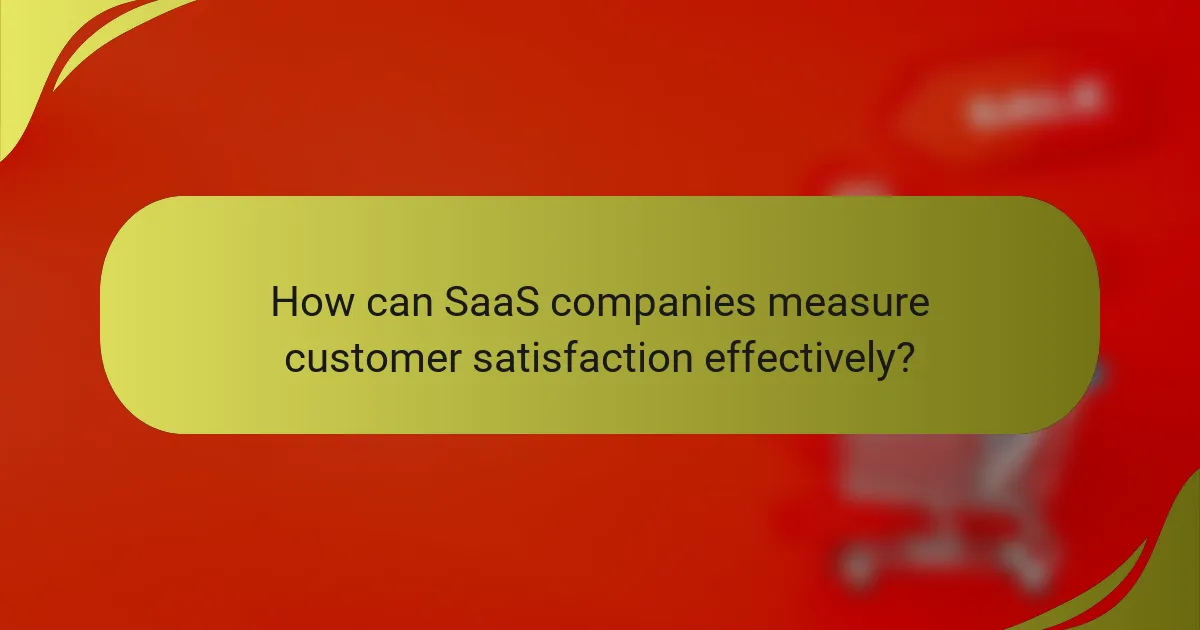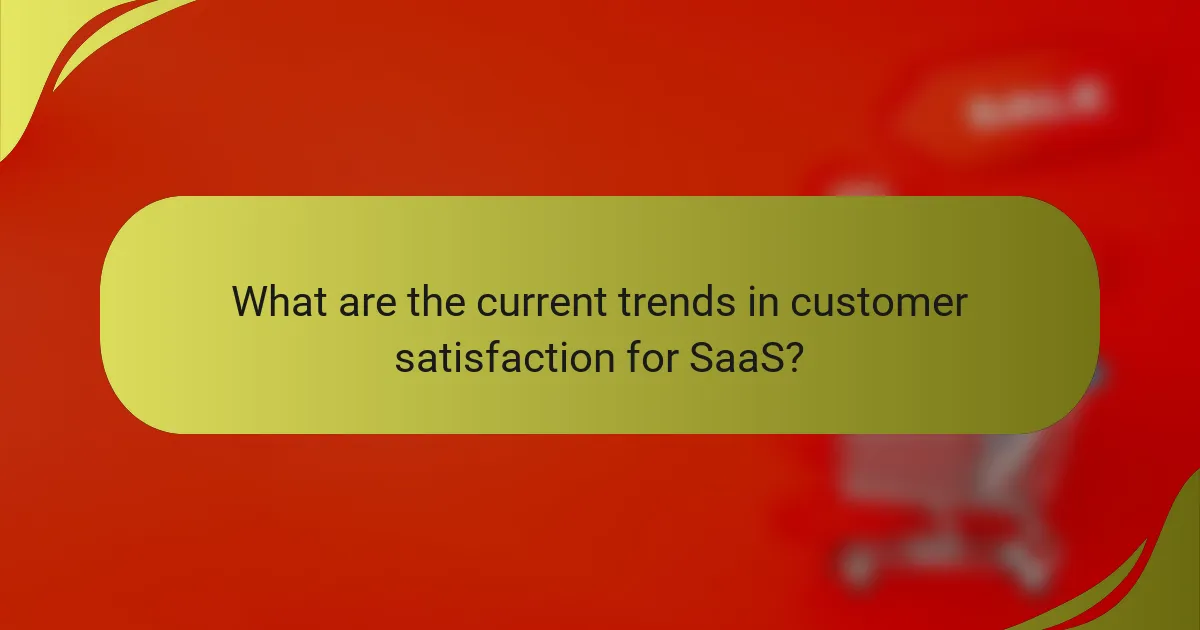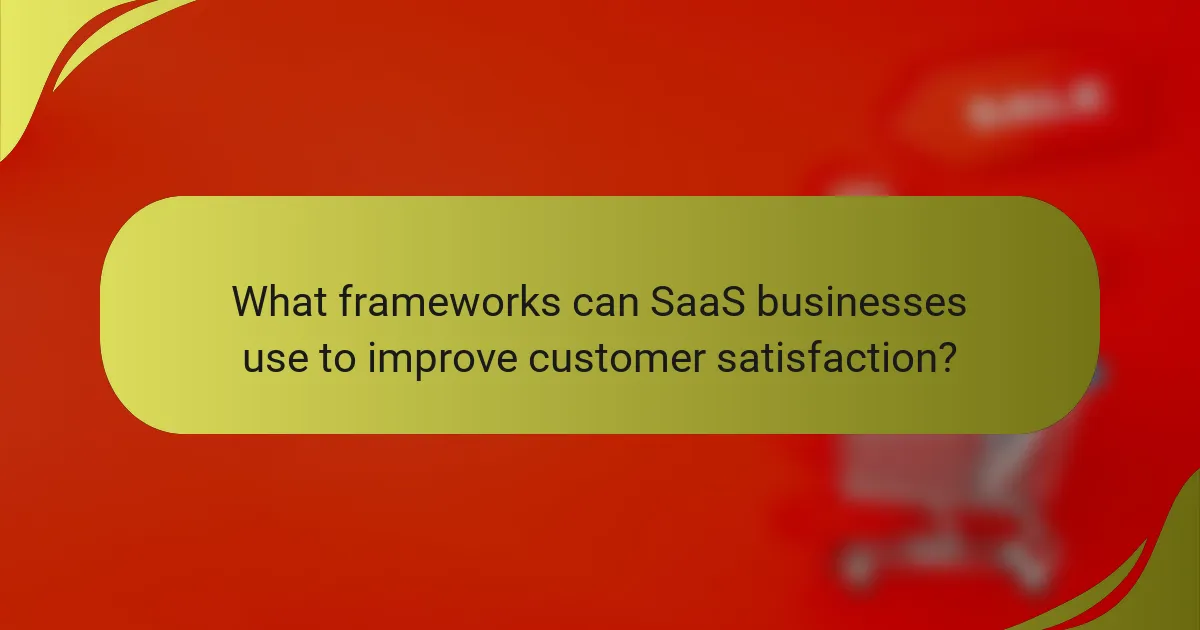In the competitive landscape of SaaS businesses, understanding customer satisfaction is crucial for success. Key metrics such as Net Promoter Score (NPS) and Customer Satisfaction Score (CSAT) offer insights into customer loyalty and experiences. By employing a combination of quantitative and qualitative measurement techniques, companies can gain a comprehensive view of satisfaction levels, while current trends emphasize personalization and AI-driven feedback analysis to enhance user engagement.

What are the best customer satisfaction metrics for SaaS businesses?
The best customer satisfaction metrics for SaaS businesses include Net Promoter Score (NPS), Customer Satisfaction Score (CSAT), Customer Effort Score (CES), Churn Rate, and Customer Lifetime Value (CLV). These metrics provide valuable insights into customer experiences, loyalty, and overall satisfaction, helping businesses make informed decisions to enhance their services.
Net Promoter Score (NPS)
Net Promoter Score (NPS) measures customer loyalty by asking how likely customers are to recommend your service to others on a scale from 0 to 10. Customers are categorized into promoters, passives, and detractors, allowing businesses to gauge overall sentiment and identify areas for improvement.
A high NPS indicates strong customer loyalty, while a low score may signal issues that need addressing. Regularly tracking NPS can help SaaS companies respond to customer feedback and enhance their offerings.
Customer Satisfaction Score (CSAT)
Customer Satisfaction Score (CSAT) assesses how satisfied customers are with a specific interaction or overall experience. Typically measured through a simple survey question, CSAT scores range from 1 to 5 or 1 to 10, with higher scores indicating greater satisfaction.
To effectively use CSAT, follow up on feedback and address any concerns raised by customers. Aim for a CSAT score above 80% to indicate a generally positive customer experience.
Customer Effort Score (CES)
Customer Effort Score (CES) evaluates how easy it is for customers to use your service or resolve issues. This metric is often measured by asking customers to rate their effort on a scale from “very low effort” to “very high effort.”
A lower CES suggests a smoother customer experience, which can lead to higher satisfaction and retention rates. Focus on minimizing customer effort by streamlining processes and providing clear guidance.
Churn Rate
Churn Rate is the percentage of customers who stop using your service over a specific period. A high churn rate can indicate dissatisfaction or better alternatives available in the market, making it crucial for SaaS businesses to monitor this metric closely.
To calculate churn rate, divide the number of lost customers by the total number of customers at the beginning of the period. Aim to keep churn rates below 5% for healthy growth and customer retention.
Customer Lifetime Value (CLV)
Customer Lifetime Value (CLV) estimates the total revenue a business can expect from a customer throughout their relationship. Understanding CLV helps SaaS companies allocate resources effectively and tailor marketing strategies to maximize profitability.
To calculate CLV, multiply the average purchase value, purchase frequency, and average customer lifespan. A higher CLV indicates a more valuable customer base, guiding decisions on customer acquisition and retention efforts.

How can SaaS companies measure customer satisfaction effectively?
SaaS companies can measure customer satisfaction through various methods that provide insights into user experiences and preferences. Effective measurement involves combining quantitative data from analytics with qualitative feedback from customers to form a comprehensive view of satisfaction levels.
Surveys and Feedback Forms
Surveys and feedback forms are direct tools for collecting customer opinions about a SaaS product. These can be distributed via email or integrated within the software itself, allowing users to share their thoughts after specific interactions or at regular intervals.
To maximize response rates, keep surveys concise and focused, ideally taking no more than a few minutes to complete. Consider using a mix of rating scales and open-ended questions to gather both quantitative and qualitative data.
Usage Analytics
Usage analytics involve tracking how customers interact with the software, providing insights into their behavior and satisfaction levels. Key metrics include frequency of use, feature engagement, and time spent on the platform.
By analyzing these metrics, companies can identify patterns that indicate satisfaction or dissatisfaction. For example, a sudden drop in usage may signal issues that need addressing, while high engagement with specific features can highlight what customers value most.
Social Media Monitoring
Social media monitoring allows SaaS companies to gauge customer sentiment and satisfaction through public interactions and feedback. By tracking mentions of the brand or product across platforms like Twitter, Facebook, and LinkedIn, businesses can gather real-time insights into customer opinions.
Utilizing social listening tools can help identify trends and common themes in customer feedback. Responding promptly to both positive and negative comments can enhance customer relationships and demonstrate that the company values user input.
Customer Interviews
Conducting customer interviews provides in-depth insights into user experiences and satisfaction levels. These one-on-one conversations allow for a deeper understanding of customer needs, preferences, and pain points.
To conduct effective interviews, prepare open-ended questions that encourage detailed responses. Aim for a diverse range of customers to ensure varied perspectives, and consider recording sessions (with permission) for later analysis.

What are the current trends in customer satisfaction for SaaS?
Current trends in customer satisfaction for SaaS focus on enhancing user experience through personalization, leveraging AI for feedback analysis, and integrating customer support tools. These strategies aim to improve engagement and retention by addressing customer needs more effectively.
Personalization in Customer Experience
Personalization is increasingly vital in SaaS customer satisfaction, as it tailors experiences to individual user preferences and behaviors. By analyzing user data, companies can offer customized features, recommendations, and communications that resonate with their audience.
Implementing personalization can involve simple tactics, such as adjusting user interfaces based on past interactions or sending targeted emails based on usage patterns. Companies should also consider user feedback to refine these personalized experiences continuously.
AI and Automation in Feedback Analysis
AI and automation play a crucial role in analyzing customer feedback efficiently. By utilizing machine learning algorithms, SaaS businesses can process large volumes of feedback from various channels, identifying trends and sentiment with greater accuracy.
Automated tools can categorize feedback into actionable insights, allowing teams to prioritize improvements based on customer needs. This approach not only saves time but also enhances the ability to respond quickly to emerging issues, ultimately boosting customer satisfaction.
Integration of Customer Support Tools
Integrating customer support tools is essential for improving customer satisfaction in SaaS. Seamless access to support resources, such as chatbots, help centers, and ticketing systems, ensures that users can find solutions quickly and efficiently.
Effective integration allows for a unified view of customer interactions, enabling support teams to provide personalized assistance. Companies should regularly assess their support tools to ensure they meet evolving customer expectations and enhance overall satisfaction.

What frameworks can SaaS businesses use to improve customer satisfaction?
SaaS businesses can enhance customer satisfaction by employing frameworks such as customer journey mapping and service blueprinting. These methodologies help identify pain points and streamline service delivery, ultimately leading to improved customer experiences.
Customer Journey Mapping
Customer journey mapping involves visualizing the entire experience a customer has with a SaaS product, from initial awareness to post-purchase support. This framework helps businesses identify critical touchpoints and moments of truth that significantly impact customer satisfaction.
To create an effective customer journey map, gather data from various sources, including customer feedback, analytics, and support interactions. Focus on key stages such as onboarding, usage, and renewal to pinpoint areas needing improvement.
Common pitfalls include neglecting to update the map regularly and failing to involve cross-functional teams. Ensure that all relevant departments contribute to the mapping process to gain a holistic view of the customer experience.
Service Blueprinting
Service blueprinting is a detailed visualization of the service delivery process, highlighting both customer interactions and internal processes. This framework allows SaaS businesses to align their operations with customer expectations, ensuring a seamless experience.
When developing a service blueprint, outline the front-stage interactions visible to customers and the back-stage processes that support these interactions. This clarity helps identify inefficiencies and areas for training or technology enhancements.
To maximize effectiveness, regularly review and revise the blueprint based on customer feedback and performance metrics. Avoid creating overly complex blueprints; simplicity often leads to better understanding and implementation across teams.

How do customer satisfaction metrics impact SaaS pricing strategies?
Customer satisfaction metrics significantly influence SaaS pricing strategies by providing insights into perceived value and user experience. Companies often adjust their pricing based on customer feedback to align with market expectations and enhance retention.
Value-Based Pricing Models
Value-based pricing models set prices according to the perceived value delivered to customers rather than solely on costs. This approach requires understanding customer needs and satisfaction levels, allowing SaaS providers to charge more when their product significantly enhances user productivity or satisfaction.
For example, a project management tool that saves teams substantial time may justify a higher price point compared to a similar tool with fewer features. Companies should regularly assess customer satisfaction metrics to ensure their pricing reflects the value users derive from their services.
Tiered Pricing Based on Satisfaction Levels
Tiered pricing based on satisfaction levels allows SaaS businesses to offer different service levels at varying price points. This strategy caters to diverse customer needs and satisfaction levels, enabling users to choose a plan that best fits their requirements and budget.
For instance, a basic tier may include essential features at a lower price, while a premium tier offers advanced functionalities and dedicated support for higher satisfaction. Regularly analyzing customer feedback can help businesses adjust these tiers effectively, ensuring they meet user expectations and maximize revenue.

What role does customer feedback play in SaaS product development?
Customer feedback is crucial in SaaS product development as it directly informs improvements and new features. By understanding user experiences and needs, companies can enhance their offerings, ensuring they remain competitive and relevant.
Feature Prioritization
Feature prioritization involves determining which product enhancements or new functionalities should be developed first based on customer feedback. This process ensures that the most requested and impactful features are addressed, aligning product development with user expectations.
To effectively prioritize features, consider using frameworks like the MoSCoW method (Must have, Should have, Could have, Won’t have). This helps categorize feedback based on urgency and importance, allowing teams to focus on delivering maximum value quickly.
Additionally, regularly reviewing customer feedback through surveys or support tickets can reveal trends in user needs. For instance, if multiple users request a specific integration, it may warrant immediate attention in the development roadmap. Avoid common pitfalls like overloading the backlog with low-impact features, which can dilute focus and resources.

